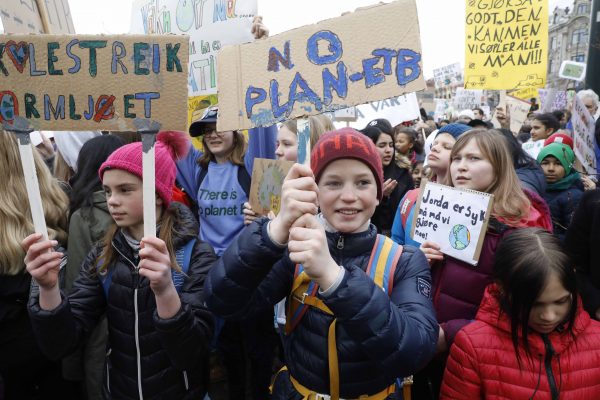As Climate Experts Warn of Looming Catastrophe, Past Bad Predictions Hurt Their Message
Humanity only has a few years to act before the world may irreversibly plunge into an environmental catastrophe of global proportions, climate experts warned in a recent report. Their calls are muffled, however, by a ballast of dozens of past dramatic predictions that have failed to pan out.
Environmental experts have been predicting upcoming doom for many decades. Most, though not all, of the prognostications, involve climatic cataclysm that appears to be just around the corner, only to fizzle out as the deadline approaches.
As the failed predictions pile up, climate experts appear to be more cautious in making their predictions too specific. The current general consensus among climate change proponents is that extreme weather events, such as droughts and storms, will become more prevalent or intense.
The recently released short-form report from the Intergovernmental Panel on Climate Change (IPCC) warns that unless carbon emissions are cut drastically and promptly, the planet will warm roughly an additional 1.1-2.4 degrees Celsius by 2100 (pdf). That would lead to a “high” or “very high” risk of wildfire damage, permafrost degradation, biodiversity loss, dryland water scarcity, and tree mortality on the land, and loss of warm-water corals in the sea. Most of the severe risks are asserted with moderate or low confidence, meaning that underlying evidence is lacking or inconclusive.
The full IPCC report hasn’t been released yet.
One of the most famous climate experts, Michael Mann, criticized the IPCC for being “overly conservative” in predicting catastrophic consequences of climate change, “including ice sheet collapse, sea level rise, and the rise in extreme weather events,” Inside Climate News reported.
But it’s been exactly these kinds of bold predictions that have undermined experts’ credibility in the past.
Environmentalist Bjorn Lomborg has collected some such failed predictions in his book, “False Alarm: How Climate Change Panic Costs Us Trillions, Hurts the Poor, and Fails to Fix the Planet.” Geologist and electrical engineer Tony Heller, who frequently criticizes what he considers fraud in current mainstream climate research, has made it a recurring theme of his climate science blog to point out failed and dubious predictions.
Examples are plentiful, stretching far into the past:
December 1939
“All the glaciers in Eastern Greenland are rapidly melting,” the Harrisburg [Pennsylvania] Sunday Courier reported.
“It may without exaggeration be said that the glaciers—like those in Norway—face the possibility of a catastrophic collapse,” the paper quoted Prof. Hans Ahlmann, a Swedish geologist, saying from a report to the Geographical Society after his Arctic expedition.
In fact, arctic ice was seen receding since 1918, according to a 1923 New York Time article.
“Last Winter, oceans did not freeze over even on the north coast of Spitzbergen,” the article said.
By comparison, this winter, sea ice did reach the shore of Spitzbergen, though in low concentrations.
Back then, however, the meltdown seemed nowhere near done.
May 1947
“The possibility of a prodigious rise in the surface of the ocean with resultant widespread inundation, arising from an Arctic climate phenomenon[,] was discussed yesterday by Dr. Hans Ahlmann, a noted Swedish geophysicist at the University of California Geophysical Institute,” an article in The West Australian read.
“The Arctic change is so serious that I hope an international agency can speedily be formed to study the conditions on a global basis,” Ahlmann said.
February 1952
“The glaciers of Norway and Alaska are only half the size they were 50 years ago,” said Dr. William Carlson, an Arctic expert, according to a newswire run by The Cairns Post in Australia.
March 1955
“There are now six million square miles of ice in the Arctic. There once were 12 million square miles,” said Arctic explorer Adm. Donald McMillan, according to Rochester, New York’s Democrat, and Chronicle.
October 1958
“Some scientists estimate that the polar ice pack is 40 percent thinner and 12 percent less in area than it was a half-century ago and that even within the lifetime of our children, the Arctic Ocean may open, enabling ships to sail over the North Pole,” The New York Times reported, noting that the Arctic ice sheet was about 7 feet thick at the time. Currently, the ice is about 7 feet thick, too.
By the 1960s, it appears that worries about the melting Arctic became not as immediate, only to be supplanted by other environmental concerns.
November 1967
“It is already too late for the world to avoid a long period of famine,” The Salt Lake Tribune reported, citing Paul Ehrlich’s prediction of famines by 1975.
Ehrlich, a Stanford University biologist and author of “The Population Bomb,” proposed lacing staple foods and drinking water with sterilizing agents to cut the growing population of the United States, according to the report.
April 1970
“Scientist predicts a new ice age by 21st century,” The Boston Globe reported, saying that pollution expert James Lodge predicted that “air pollution may obliterate the sun and cause a new ice age in the first third of the new century.”
October 1970
Ehrlich went on to predict that America would be rationing water by 1974 and food by 1980, California’s Redlands Daily Facts reported.
July 1971
“The world could be as little as 50 or 60 years away from a disastrous new ice age,” said atmospheric scientist S. I. Rasool of the National Aeronautics and Space Administration (NASA) and Columbia University, The Washington Post reported.
January 1972
“We have 10 years to stop the catastrophe,” said Maurice Strong, then-U.N. environmental secretary, regarding the world’s environmental problems, according to the Swedish newspaper Dagens Nyheter.
December 1972
Two Brown University geologists wrote a letter to President Richard Nixon, reporting that a conference attended by “42 top American and European investigators” concluded, “a global deterioration of climate, by order of magnitude larger than any hitherto experienced by civilized mankind, is a very real possibility and indeed may be due very soon.”
“The present rate of cooling,” they said, “seems fast enough to bring glacial temperatures in about a century, if continuing at the present pace.”
January 1974
“Space satellites show new Ice Age coming fast,” The Guardian reported.
June 1974
“Another Ice Age?” a Time Magazine headline asked.
“Telltale signs are everywhere—from the unexpected persistence and thickness of pack ice in the waters around Iceland to the southward migration of a warmth-loving creature like the armadillo from the Midwest,” the article said.
January 1978
“An international team of specialists has concluded from eight indexes of climate that there is no end in sight to the cooling trend of the last 30 years, at least in the Northern Hemisphere,” The New York Times reported.
A year later, the paper was reporting the opposite.
February 1979
“There is a real possibility that some people now in their infancy will live to a time when the ice at the North Pole will have melted, a change that would cause swift and perhaps catastrophic climate changes,” The New York Times said.
May 1982
Mostafa Tolba, then-executive director of the U.N. environmental program, said that if the world didn’t change course, it would face “an environmental catastrophe which will witness devastation as complete, as irreversible, as any nuclear holocaust’’ by the year 2000, according to The New York Times.
September 1988
The small island nation of Maldives was threatened to be completely covered by “a gradual rise in average sea level” in 30 years, Agence France-Presse reported, noting that “the end of the Maldives and its people could come sooner if drinking water supplies dry up by 1992, as predicted.”

The Maldives are still nowhere near underwater. In fact, despite the COVID-19 pandemic’s decimation of tourism, the nation still attracts new developments. Just last week, an Emirati development company awarded a $148 million contract to build 120 luxurious over-water and beachfront villas on Maledives’ South Male Atoll, Hotelier Maledives reported.
June 1989
“A senior environmental official at the United Nations, Noel Brown, says entire nations could be wiped off the face of the earth by rising sea levels if global warming is not reversed by the year 2000,” California’s San Jose Mercury News reported.
“Coastal flooding and crop failures would create an exodus of ‘eco-refugees,’ threatening political chaos,” said Brown, then-director of the New York office of the U.N. Environment Program.
March 2000

“Snowfalls are now just a thing of the past,” The Independent wrote. “Children just aren’t going to know what snow is,” said David Viner, a senior research scientist at the climatic research unit of England’s University of East Anglia, noting that within a few years, winter snowfall would become “a very rare and exciting event.”
While snow is rare in southern England, it still comes pretty much every winter.
December 2001
“The climate changes could potentially extirpate the sugar maple industry in New England” within 20 years, according to George Hurtt, co-author of a 2001 global warming report commissioned by the U.S. Congress, according to Albuquerque Journal.
Today, New England still produces plenty of maple syrup.
February 2004
The Guardian reported on a secret Pentagon report that predicted climate change will lead to nuclear war, major European cities will sink into the ocean, and Britain would descend into a “Siberian” climate by the year 2020.
January 2006
“Unless drastic measures to reduce greenhouse gases are taken within the next 10 years, the world will reach a point of no return,” The Associated Press wrote, paraphrasing Al Gore, a prominent global warming advocate.
November 2007
This year was the “defining moment” of the climate change fight, according to Rajendra Pachauri, then-head of the U.N. climate panel. “If there is no action before 2012, that’s too late,” the official said, according to The New York Times.
November 2007
“The Arctic Ocean could be free of ice in the summer as soon as 2010 or 2015—something that hasn’t happened in more than a million years,” Canada’s Canwest News Service reported, paraphrasing polar researcher Louis Fortier.
December 2007
“Arctic Sea Ice Gone in Summer Within Five Years?” said an Associated Press headline.
“At this rate, the Arctic Ocean could be nearly ice-free at the end of summer by 2012,” said Jay Zwally, a NASA climate scientist, according to the article.
December 2007
“Arctic summers ice-free ‘by 2013’” the BBC reported.
“Our projection of 2013 for the removal of ice in summer is not accounting for the last two minima, in 2005 and 2007,” a researcher from the Naval Postgraduate School, Monterey, California, told the BBC.
“So given that fact, you can argue that maybe our projection of 2013 is already too conservative.”
March 2008
“If Norway’s average temperature this year equals that in 2007, the ice cap in the Arctic will all melt away, which is highly possible judging from current conditions,” said Olav Orheim, head of the Norwegian International Polar Year Secretariat, according to Xinhua, China’s official propaganda mouthpiece.
Norway’s average temperature did slightly increase from 2007 to 2008. The ice didn’t melt.
April 2008
“The North Pole could be ice-free in 2008,” reported New Scientist.
“There is this thin first-year ice even at the North Pole at the moment,” said Mark Serreze, director of the National Snow and Ice Data Center, according to the article. “That raises the specter—the possibility—that you could become ice-free at the North Pole this year.”
June 2008
“We’re actually projecting this year that the North Pole may be free of ice for the first time [in history],” said David Barber, of the University of Manitoba, according to National Geographic News.
June 2008
“In five to 10 years, the Arctic will be free of ice in the summer,” The Associated Press reported, paraphrasing James Hansen, director of NASA’s Goddard Institute of Space Sciences.
December 2009

“The Arctic Ocean may be nearly ice-free in summer as early as 2014,” Al Gore said, according to USA Today.
September 2012
“Enjoy snow now … by 2020, it’ll be gone,” The Australian reported. It still snows in Australia. Last year’s snowfall was, in fact, significantly above average.
July 2013
“Ice-free Arctic in two years heralds methane catastrophe—scientist,” The Guardian reported.
February 2014
“The End of Snow?” asked a New York Times op-ed headline, talking about declining snowpack in the Western United States. The past decade overall has marked no significant snowfall decline in the region.
July 2017
After then-U.S. President Donald Trump pulled the United States out of the U.N. Paris Climate Agreement, physicist Stephen Hawking said, according to BBC: “We are close to the tipping point, where global warming becomes irreversible. Trump’s action could push the Earth over the brink, to become like Venus, with a temperature of 250 degrees [Celsius] and raining sulfuric acid.”
August 2017
“Snowy retreat: Climate change puts Australia’s ski industry on a downhill slope,” The Sydney Morning Herald reported. It’s been snowing quite as usual in Australia in recent years, weather data indicates.
January 2018
“The chance that there will be any permanent ice left in the Arctic after 2022 is essentially zero,” said James Anderson, a Harvard University professor of atmospheric chemistry, according to Forbes.

July 2020
“The end of snow,” said an Australian Geographic headline. “Could a warming climate be putting Australia’s magnificent alpine landscapes at risk?”
There was no particular lack of snow in Australia in either 2021 or 2022.
December 2021
The Los Angeles Times ran a story headlined, “A ‘no snow’ California could come sooner than you think.”
A few weeks later, the UC Berkeley Central Sierra Snow Lab announced that California just had the snowiest December on record.
August 2022
“The End of Snow Threatens to Upend 76 Million American Lives,” Bloomberg reported, referring to predictions of snow disappearance in the western United States.
A few months later, the Sierra Nevada mountains would see its second snowiest winter on record.
March 2023
“Arctic ice has seen an ‘irreversible’ thinning since 2007, study says,” The Washington Post reported.
The ice hasn’t thinned much over the past decade.
Since 1979, the summer minima have seen a record low every 5-7 years. Since 2012, however, there has been no new record, the data shows.
By Petr Svab
You can return to the main Market News page, or press the Back button on your browser.

